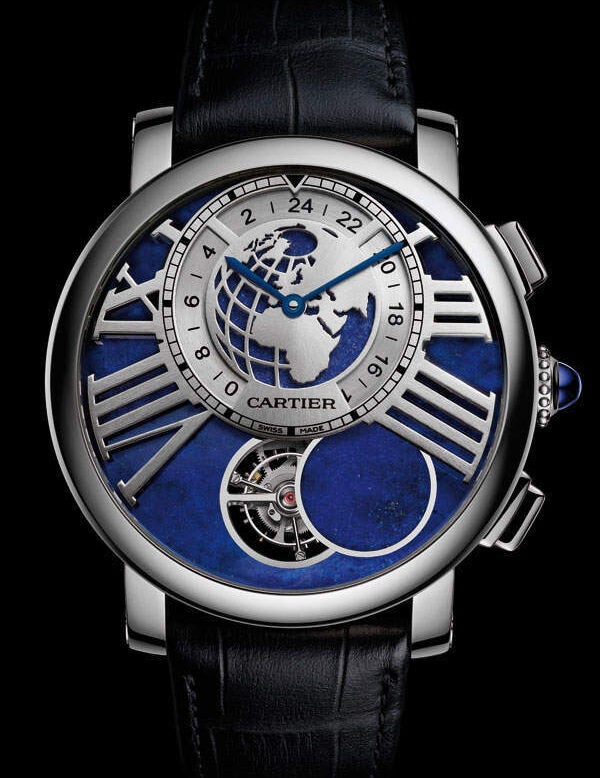

SPACE AND TIME
Depending upon the cloud cover where you are, how closely you pay attention to the little diagrams on the page corners of certain diaries or whether you plant your crops according to the lunar cycle (some still swear by it), you may or may not know when the full moon falls in a given month.
With a watch such as A Lange & Söhne’s Grand Lange 1 Moon Phase, you can’t fail to notice — in fact, you’ll find yourself staring at your own reflection in its gleaming lunar surface.
At full moon, a 4mm convex mirror of perfectly polished white gold sits in the centre of a large, crescent-shaped opening. Surrounding this tiny, mirrored moon is a speckled Milky Way of microscopic stars, against a background of the inkiest blue.
Imperceptibly, the moon passes through this display every month, matching the cycle of the actual moon, waxing from the left and waning to the right (in fact there are two gold circles facing each other on the rotating disc, though of course you only ever see one). If you set it correctly and keep it running, the lunar display will take 122.6 years to be a day out.
Assuming you don’t plant your crops according to the lunar cycle, it’s of no more use than those curious diary diagrams — but an awful lot more bewitching. Watchmakers call the moon phase a ‘poetic complication’, meaning an indication whose value is whimsical rather than useful. Traditionally moon phase watches present a classically imagined Man-in-the-Moon visage rotating through its cycle, though the gleaming golden disc of Lange’s version conveys its own sense of entrancement.

Pictured above: De Bethune’s DB28 Digitale and (top) A Lange & Söhne has stars in its eyes with the Grand Lange 1 Moon phase
The ‘equation of time’ display shows the variable difference between time as depicted on a clock and mean solar time as it would appear, say, on a sundial. Entire physics books are devoted to that, but for now we’ll stick with the simpler, and rather more evocative, moon phase — something that, like a sundial, harks back to the earliest forms of timekeeping.
Before mechanical devices, celestial bodies provided the most accurate method for telling the time. In clocks, the indication of a simple 29½-day lunar cycle goes back as far as the 15th century, while a basic lunar age and phase indication was common on domestic clocks by the 16th century, and gave us a visual language that still lingers.
Of course, back then, in days when there were no artificial street lights, knowing when the moon would be at its brightest was advantageous, while the popularity of lunar displays also reflected the wider interest (or superstitions) around astrology.
Nevertheless, as the former curator of clocks and watches at the British Museum once told me, a lunar indication ‘was often just a matter of a more complex clock having swank value’. Plus ça change. In the early 17th century the lunar display made its way on to watch faces, and 150 years later it was adding dazzle to the kinds of high-complication timepieces made by the greatest watchmakers of the day, such as Abraham-Louis Breguet and Thomas Mudge.
Luxury sphere
It continues to be a sign of horological swank. Cartier, for instance, has this year unveiled a remarkable reworking that places a tourbillon in a dial of burnished lapis lazuli. Press a button and a circular disc swings out, partly covering the tourbillon according to the cycle of the moon — at full moon it’ll be uncovered, and at new moon it’s fully covered. I’m undecided about this piece, since it denies the continual, gentle rotation that’s surely part of the moon phase’s mysterious allure, but there’s no denying the lavishness or ambition of the design.
Recently there’s been something of an arms race around just how accurate a moon phase mechanism can be engineered to be. Lange’s 122.6-year precision is nothing, for instance, compared with that achieved by Ochs und Junior, a tiny revisionist brand from Lucerne that produces a minimalist moon phase that will take precisely 3,478.27 years to be out by a day — a feat all the more remarkable for the fact that the mechanism consists of just five parts.

Pictured above: Cartier’s Rotonde de Cartier Earth Moon features a highly elaborate moon phase
This is so much horological navel-gazing, perhaps, especially when you consider that any time the watches are left alone for a few days, the movement — including the moon phase — will drain its power and stop, requiring resetting when the mainspring is wound up again.
That being said, even those at Ochs und Junior would probably doff their caps to the undisputed king of astronomical watches (yep, that’s a genre), Dutchman Christiaan van der Klaauw. When not producing mini-Orreries for the wrist, as he recently has done for the Parisian jewellery house Van Cleef & Arpels, van der Klaauw has created a lunar indication in which a spheroid moon rotates in the dial to an accuracy of no less than 11,000 years.
Blue streak
Employing a similar three-dimensional moon concept as van der Klaauw, but perhaps more visually enthralling and certainly more outlandish, are the lunar watches of de Bethune. The Swiss company, founded a bit more than a decade ago, specialises in watches that push traditional watchmaking in inventive new directions, using new materials and clever designs that seem influenced as much by Star Trek as by traditional pocket watches.
The firm’s calling card has become its moon phase, in which a ball, half polished titanium and half deeply blued steel, turns in the dial (the titanium representing the brightness of the moon, and the blued steel the shadow).
This year de Bethune has come out with two extraordinary new iterations of this. The DB28 Digitale has the lunar sphere surrounded by a glossy circle of stars and a large guilloché-patterned dial, with a jumping-hours window above it and a turning disc for the minutes — a kind of Breguet-meets-Starship Enterprise proposition. Even weirder is the Dream Watch 5, based around the same movement and timekeeping display, with the sphere sitting pilot-like in the cockpit.
Back in the world of traditional haut de gamme watchmaking, the moon phase, as a calendar function, naturally features in perpetual calendar pieces from brands such as Patek Philippe, Breguet and Jaeger-LeCoultre. For the most spectacular example, however, we return to where we started, with Germany’s A Lange & Söhne.
Its Richard Lange Perpetual Calendar Terraluna, also launched in January, places the moon complication on the back of the watch in quite astonishing fashion. A central disc, bearing a map of the earth, rotates every 24 hours, surrounded by an outer disc of iridescent blue carrying around the moon and stars.
The moon goes through its phases as it turns around the dial every 29½ days, with (for those keeping score) a not-to-be-sniffed-at 1,058-year precision. The masterstroke is that the balance wheel — the beating heart of the watch, exposed at the outer edge of the movement — performs the role of the sun: any part of the earth disc facing it is, at that moment, in sunlight.
‘We had a movement designer who is a real fan of astronomy, it’s his hobby, and he came up with this idea,’ Lange’s head of watchmaking, Anthony de Haas, says. ‘Many people don’t understand why the moon looks as it does in the sky, and this actually explains the physical phenomenon. But with the balance wheel, you take the heart of the movement as the sun, just as the sun is the heart of life — if there’s no sun there’s no life, and it’s the same for the watch.’
Even the hardest cynic should be able to find the poetry in that.
STEEL YOURSELF
Last year Rolex celebrated the 50th birthday of its most important steel watch, the Cosmograph Daytona, with a lavish platinum version. It stands to reason, then, that Patek Philippe, for whom platinum and gold are its stock in trade, should kick off its 175th-anniversary year with a rare complicated watch in steel.
Officially, the ref 5960 annual calendar chronograph — on a delicious bracelet — has no connection to the birthday, but its sheer uncommonness makes it a highly collectible prize nonetheless.
PAINT IT BLACK
One of the most subtly ingenious watch designs of the recent era is the Perpetual 1 from the small but historic brand H Moser & Cie.
A minimalist masterpiece, it simplifies not only the perpetual calendar display, but also the operation.
Moser underwent a takeover a year ago, and the first fruit of the new regime is rather interesting: a sleek, all-black version of the Perpetual 1 with a titanium case, as singular a model as the firm has produced. Understated ultra-luxury — but not too understated — at its finest.
UPPING THE ANTE
An expert once told me the most dangerous ‘sport’ for mechanical watches was poker: the furious slamming-down of a wrist after a losing hand is the kind of shock that busts a movement.
Christophe Claret should perhaps take heed, since he’s created a watch that actually mechanises the game itself. Tiny ‘cards’ are seen through apertures in the dial, dealt by buttons in the case, for a game of up to three. The all-in price tag is CHF160,000 (£110,000).







